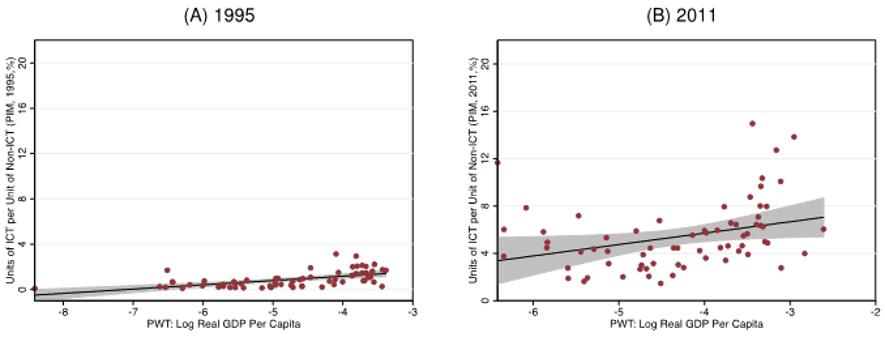Although globalisation has been an ongoing process for centuries now, the most important recent event relating to this process of economic internationalisation has been the globalisation of finance and technology, taking place mostly after the turn of the century. This latest step has been the one that has generated greatest controversy and debate among economists and political scientists. Long debates have developed around this particular subject and around themes such as international inequality (as global inequality has steeply decreased), technological diffusion and adoption, and numerous other issues. Arguing and building up new theories and ideas among people with varied opinions is not at all problematic. Problems arise when the debate loses its rationality, respect for data and evidence, and turns towards dogmatism and spurious arguments. This has occurred recently with some particular sectors of the left and the protectionist right (‘alt-right’ movements), which have turned their back on data and began to introduce dogmatic arguments to the globalisation debate. In the course of this article, sticking with the evidence and data throughout, I will try to sketch a brief outline of how globalisation has helped to reduce poverty and improve living standards in developing countries. I will also address the reasons why it is not always the extent to which technology is widespread, but rather the way in which it is used and implemented, that is the most important factor for modern development.
According to a study released by the Yale Center for the Study of Globalization and produced by Laurence Chandy and Geoffrey Gertz in 2011 (With Little Notice, Globalization Reduced Poverty- Yale University), the process of globalisation has been one of the main drivers of poverty reduction throughout the last couple of decades. The World Banks registers “absolute poverty” as living on less than $1.90 per day, adjusted to 2011 PPP. Global poverty levels stood at 36% in 1990, went down to 25% in 2005, and are now nearly at 9.5%. This, whichever way we look at it, is a huge success, but doesn’t mean all work is done.
In the 1970s, more than 84 percent of the Chinese population lived in absolute poverty. By 2005, that number had dropped to 16 percent. It now stands at 0.7 percent. For global poverty data, this reduction of Chinese poverty rates was hugely important. In a country with a population of over 1 billion citizens, a poverty reduction from 84 percent of the population to less than 0.7 percent in less than 50 years is of crucial significance for global poverty. But this reduction of poverty hasn’t been equal for all countries or regions. It’s true that almost every country has improved its socioeconomic situation thanks to globalisation, according to several indicators (life expectancy, child mortality, literacy, access to clean water…), but some countries or regions have fared much better than others. According to data from the World Bank, in 2015 the absolute poverty rate in sub-Saharan Africa still stood at 41%, and 27 out of the world’s 28 poorest countries are located in the sub-Saharan Africa region. On top of it, it should be mentioned that whilst in some traditionally poor countries such as India poverty was greatly reduced (from 45.9% in the 1990s to 21.2% in 2011), other countries maintained an absolute poverty rate above 50% from the 1970s until 2010, with minimal poverty reductions since then. Many ideas and theories have been developed around this issue throughout the last couple of decades, but a relatively new debate around technology and emerging countries’ adaptation to it has ignited a new branch or research and academic discussion. Do developing countries need greater access to ICT or do they just need to employ it more productively? Is it just a problem of accessibility or also of usage?
To answer this question, I will make reference to two different academic articles (A roadmap for digital-led economic development and Do poor countries really need more IT?), which present a compilation of papers on the issue and discuss the alternative answers to the former questions.
In developed nations, more than 90% of citizens have connection to the internet, while this figure reduces to less than 20% in emerging countries. So, at first glance, it could seem that the sole possible solution to emerging nations’ productivity issues could be to increase the rate of connectivity by increasing investment in those areas. A very positive spillover of digital technologies, according to a paper by Hjort and Poulsen, is that these technologies do not only create employment in industries related to their principal activities, but also in many other industries and sectors of the economy, mainly by increasing Total Factor Productivity (TFP).

But technology (in its broadest sense) doesn’t just increase productivity through, for example, automation, but also helps to create new connection methods between economic actors, which in itself facilitates exchanges and transactions. We only need to look at the great pace of development of international supply chains after the explosion of ICT in the 1990s. Richard Baldwin explains this perfectly in his book The Great Convergence, illustrating the way in which new paths for economic development are created when firms and citizens in developing countries truly understand technological change. A key example of this is organisational technologies, which provide a new global division of labour that improves decision making whilst registering greater productivity and efficiency levels.
In that vein, a key question is: do poor countries need increased ICT provision? In the previously mentioned article about ICT availability and use in developing countries, economists Maya Eden and Paul Gaggl highlight that in low income countries, the value of ICT capital represents a smaller share of the aggregate capital stock than in developed nations, and differences are greater still when measured in real terms. This is mainly because ICT capital tends to be, relatively speaking, more expensive in developing countries, while labour is relatively cheaper in developing than in developed countries, which creates an even greater than envisaged imbalance in the capital-labour ratio. The data of their study is presented in a graph (reproduced below) where the independent variable (Real GDP per capita) is displayed in a logarithmic scale, while the dependent variable (Units of ICT per Unit of Non-ICT) is presented in a regular scale, presenting a positive relationship between the two variables, with some major deviations from the trend (especially for the 2011 data).

From these two graphs, presenting the same study at different periods in history, we can conclude that the cause of developing countries having less ICTs is precisely their previously low productivity and low capital-labour ratios, which explains the low and ineffective adoption of new technological capital. One of the most important conclusions from this study is that variation across countries in ICT use is related, apart from real GDP per capita, also to industrial composition, with the latter being the main friction creators for ICT adoption and technological diffusion.
In conclusion, evidence illustrates that globalisation has helped nearly every developing country to achieve a better living standard by reducing poverty and stimulating significant improvements in various indexes related to education, healthcare, life expectancy and others. Although it has recently been argued that the amount of ICT capital in emerging economies has a direct relationship with real GDP per capita, evidence shows this argument is valid only up to a point, when an efficient technological adoption and implementation becomes more important than simply increasing the ratio capital-labour of an economy. Liberating many developing countries (especially in sub-Saharan Africa) from their autocratic and (often) totalitarian governments would be the first step towards allowing a freer flow of goods, services, people and information; these are some of the most important keys to prosperity.






